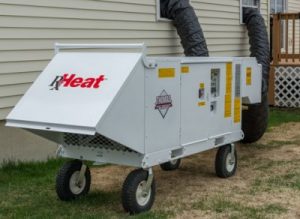
Nowadays, the green way slowly takes over the traditional chemical pest treatments.
More and more people are looking for the non-toxic, environmental friendly solutions. And there’re plenty.
One of those treatments with zero toxicity against termites is freezing.
How does it work and what termites it can help you with?
Hide content
- Which termites?
- How to tell the difference?
- How does termite freezing work?
- Precautions
- Freezing
- Useful articles
- Conclusion
Which termites?
If you don’t know this – there’re two kinds of termites that are threatening the households.
First, and the more destructive one, is the Subterranean termite. The infamous Formosan supertermite is a member of this group.
Learn more about subterranean termites: signs of their activity; best methods of treatment and DIY methods. Eastern subterranean termites and their tunnels and tubes with photo.
These pests do not reside in your house, even if they forage for cellulose in it.
These termites are known to go really long distances from their nest to search for food. And the nest itself is normally located somewhere in the soil.
Good chance it’s in your garden, but otherwise, they can be actually living in the soil of the house across the street. So, what I’m trying to say that, simply killing all the workers that are eating your timber, will not save the situation.
If you do just that – the termites will come back. Freezing can be used against them, but only combining it with the other measures, such as soil treatment and baiting, will do the full extermination possible.Drywood termites are slightly easier. This termite lives where it eats. The drywood termites don’t need a source of moisture, as they have a special evolutionary adaptation, that helps them to extract water even from the driest piece of timber.
If the infestation is contained in, for example, one piece of furniture, you can easily use freezing as the only fighting method. Killing termites in this wood will mean the overall extermination in this case.
Learn more about drywood termites: signs of their activity; best methods of treatment: spot treatment and DIY methods; how to get rid of them in furniture?
How to tell the difference?
There’re several signs that can tell you if you’re suffering from drywood or subterranean termites. First, and the most obvious one is a swarm.
Swarm occurs when the colony has reached its full development and is ready to reproduce itself. For this purpose, the winged reproductive termites develop in the nest. One humid summer or spring morning the alates take off from the nest up in the air, to find a mate and a perfect place for the new colony.
So, if you’re present at the time of the swarm, you are in a perfect position to determine the exact place of the nest, and subsequently understand which termites are haunting you.
If the insects emerge from under the ground – it’s obvious they are subterranean.
When the whole armchair takes off – you won’t be surprised that it’s drywood termites you’re going to fight.
Another signs are the mud tubes and frass. Usually, the frass is the sign of the drywood termite infestation. Essentially those are pellets of termite droppings, that resemble sawdust.
If you have noticed some of it next to a wooden object, first, think “is there any reason the sawdust would be here?”. If the answer is “no”, it might be frass. Try to do the following: clean the dust and see if it reappears.If the droppings are there again in few days – you’re surely looking at frass. The subterranean termites usually do not leave it.
The mud tubes are sheltered corridors that subterranean termites use to enter the building, without being exposed to, for example, sunlight. They are grayish in color and often connect the soil with wood. For example, they might go over the concrete, to the wooden step.
If you found any presence of mud tubes – break into them with the sharp end of the screwdriver. If the corridor seems moist – it’s an active one, so the infestation is going on right now. Drywood termites never build the mud tubes.
Here you can learn more information about effective termite control remedies: Bora-Care, Boric acid, Borate, Fipronil, Chlorpyrifos, Chlordane, Borax, Timbor, Termidor, Terminator, Phantom, Lorsban, Biflex, Terro. You can choose different forms, such as – foam, liquid, powder.
How does termite freezing work?
The idea of freezing termite treatment is extremely simple. The termites, though found in any other continent, were never living in Arctic. They prefer tropical forest and warm temperatures (though not a direct sunlight). Do termites freeze to death?
So, they do not survive with the temperatures lower then minus 20 degrees Fahrenheit. So if you chill them enough, the termites will simply die inside the wood.
Interesting: As much as termites dislike the cold, they run away from the heat too. So, if you’re looking through the natural ways of termite extermination, don’t forget to check out the heat treatments available.Here you can learn more information about termite bait systems: Advance, Green, CSIRO, Nemesis, Exterra, Firstline, Terminate. Also find out how to make baits by yourself and how to refill them?
Precautions
There’s not much to do, if you are going to do the freezing with the natural cold.
One thing you should consider is, if you’re dealing with sensible lacquers or paint on the furniture, if they might suffer from treatment you better choose the other option.
Another thing is the moist. After the treatment you don’t want your object to be soaked. This might destroy the wood structure with more efficiency then any termite.
So, if you are making a DIY version and simply placing the object on ice – make sure you sealed it in plastic, so the humidity doesn’t compromise the looks of your furniture afterwards.
When you’re using the liquid nitrogen, for example, to exterminate termites in the wooden walls, keep in mind that this can have an impact on the decorations. The wallpapers might simply fall off the wall.
But this is the minor problem. The essential thing is to make sure there’re no pipes or electricity cords you might damage by drilling the wall or by nitrogen itself. If the treatment is performed by professionals, inform them about all the house communications prior to freezing.Freezing
There’re three ways you can freeze the object to the temperatures needed:
- Place it outdoors;
- Put it in the freezer;
- Use the liquid nitrogen.
If in your areas the temperatures are getting low enough in the winter times, you can try to simply take the infested wood outside. Actually, the subterranean termites might seem to cease their activity in winter. Don’t think they are gone forever – the termites simply retreated to their nest and will stay underground until better times.
The other DIY freezing way of treating the wood is placing it in the freezer. Obviously, this will work if the object is small enough. And don’t forget to seal it before the treatment in plastic, so the moist doesn’t penetrate the wood structure.
Now, let’s see what professional pest exterminators have to offer.
Generally, the pest operators don’t list the freezing as one of their primary methods, as it is considered to be unreliable with its 70 to 100 percent efficiency rate.
If you are searching for someone to perform a proper nitrogen freezing, you’ll need to check around for the operators advertising as green.
Some operators will try to push you to do the full scale structural tenting, and here you should decide yourself. If there’re only few contained infestation spots, the freezing might be worthwhile.
The best is if the professionals use some fiber-optic equipment to determine the exact places the treatment is needed.Now, the method itself has few good points and some drawbacks.
The good points are:
- Liquid nitrogen is non-toxic.
- It takes few hours for the termites to freeze to death.
- In case of localized infestations, the freezing lets to avoid costly treatments like structural fumigation.
However, there are some cons:
- For the injection of the nitrogen, the walls or fascial board will have to be drilled. And this is a damage itself.
- There’s a danger of doing harm to the electrical wiring and household items.
- Only one small area can be treated at one time.
- If you wish to use it for the extensive areas, the cost will be higher than using the chemicals.
Useful articles
If you interested in more information of termites we recommend you to read the following articles:
- All types of termites. Are they harmful to humans? Can they bite you? And what is the difference between drywood and subterranean ones?
- What does swarmers of different species look like: drywood, subterranean, formosan?
- Signs of infestation outside and in the house: in walls or furniture.
- How to treat them at home and in the yard: in wood or in fence. How long this process lasts and what is pre-construction and soil treatment?
- What does termite holes look like? What is droppings and is it toxic to humans? Do termites make noises?
- Posible termite damage, how does it look like? Examples of damage in walls and wood floors.
- All about flying termites: how do they look like, swarming season and what to do if there are swarmers in your house?
- How do they do nests and mounds? How to find it in your garden or inside the house?
- Termite life cycle – from egg to larvae. And social hierarchy: workers, soldiers, queen.
- Did you know that termites can infest living trees, for example a palm or a pine tree. They also like to live in stumps.
- You can prevent the infestation by using barriers, such as: HomeGuard, Physical systems, Safeguard, Stainless steel mesh, Kordon.
- If you want to get rid of termites naturally, learn more about such methods as: heat treatment, orange oil, using nematodes.
Conclusion
To summarize all of the above, freezing is an all-natural method with questionable efficiency.
We would certainly recommend to use it in case of the localized drywood termite infestation in the furniture.
But if you’re suffering from multiple infestations in structural parts of the house, remember, that it’s hard to stay absolutely green in our age and let the professionals to use the chemical treatments.

